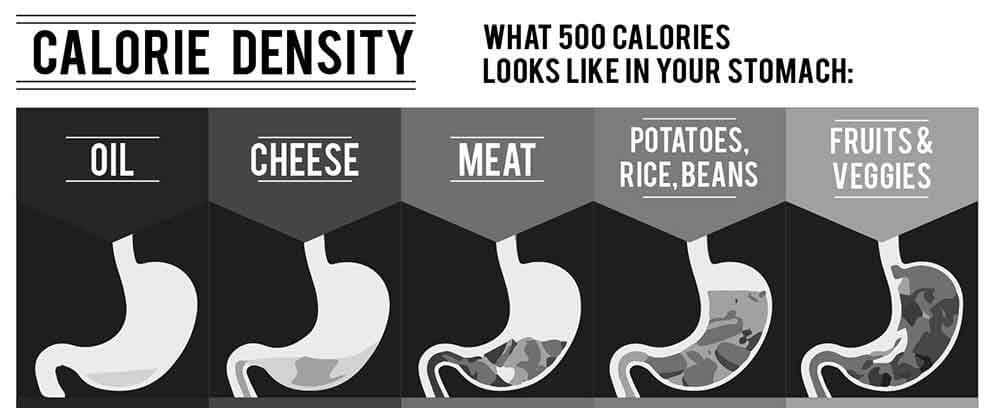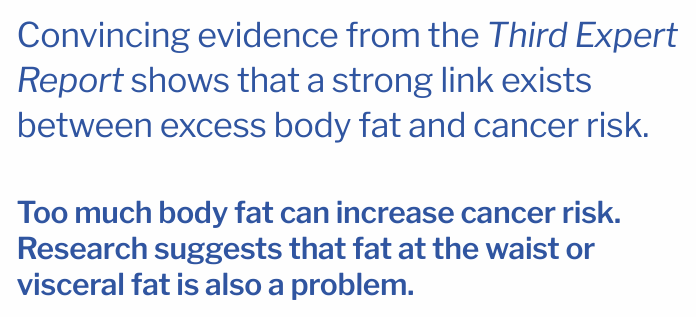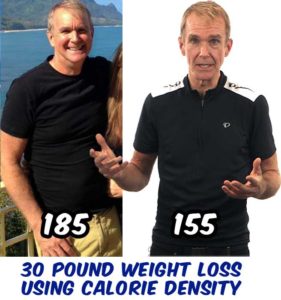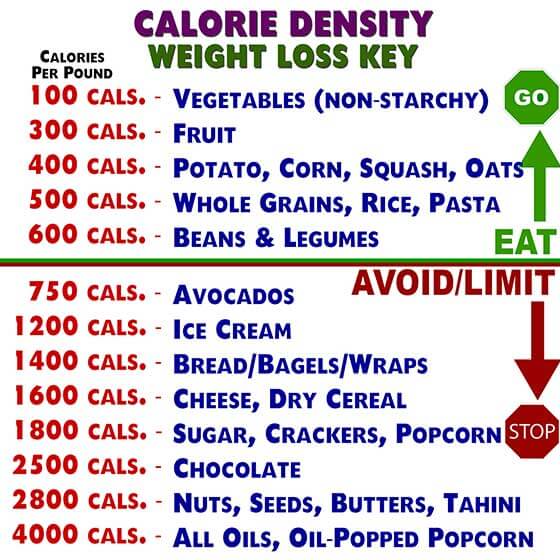Weight Loss
The Principles of Calorie Density:
How to Eat More, Weigh Less & Live Longer
In order to lose excess weight and keep it off for good, we recommend the principle of calorie density. Following is an article by plant-based dietitian Jeff Novick, MS RD, on the subject.
Eating by calorie density means focusing on foods which are less calorie dense, hence you can eat more of these foods while consuming a low amount of calories. Vegetables are the lowest in calorie density – around 100 calories per pound. Oil is the most calorie dense food, at 4,000 calories per pound.
You can see in the image below just how much 500 calories of different types of foods will fill your stomach. Foods like oil, nuts, and dairy products are high in calories, and don’t fill your stomach much. So it’s very easy to over-consume calories if you are eating a significant amount of foods like these that are calorie-dense.

But by generally centering your diet around foods lower in calories, you don’t have to pay attention to calories. You palate adjusts to these foods so that they are enjoyable, and you can eat to satiety without consuming an excess of calories. Eating this way will help your body naturally arrive at its ideal weight without having to count or even think about calories or restriction.
These are the pillars of eating by calorie density:
1) Hunger & Satiety –
Whenever hungry, eat until you are comfortably full. Don’t starve and don’t stuff yourself.
2) Sequence Your Meals –
Start all meals with a salad, soup and/or fruit. This way, you fill up on the foods lowest in calorie density and are less likely to overeat on foods higher in calorie density.
3) Don’t Drink Your Calories –
Avoid liquid calories. Eat/chew your calories, don’t drink or liquefy them. Liquids have little if any satiety so they do not fill you up as much as solid foods of equal calories.
4) Dilution is the Solution –
Dilute out high calorie dense foods/meals. Use the “50/50 Rule”: Dilute the calorie density of your meals by filling 1/2 your plate (by visual volume) with intact whole grains, tubers, starchy vegetables and/or legumes, and the other half with vegetables and/or fruit.
5) Be Aware of the Impact of Vegetables vs Fat/Oil –
Vegetables are the lowest in calorie density while fat and oil are the highest. Therefore, adding vegetables to any dish will always lower the overall calorie density of a meal while adding fat and oil will always raise the overall calorie density of a meal.
6) Limit High Calorie Dense Foods –
Limit (or avoid) foods that are higher in calorie density. These include dried fruit, high fat plant foods (nuts, seeds, avocados), processed whole grains (breads, bagels, crackers, dry cereal, tortilla’s, popcorn, etc). If you use them, incorporate them into meals that are made up primarily of low calorie dense foods and think of them as a condiment to the meal. For example, add a few slices of avocado to a large salad, or add a few walnuts or raisins to a bowl of oatmeal and fruit.
In addition, include about 30-60 minutes of activity a day (including some aerobic, resistance and flexibility exercise). Aim for a BMI of around 18.5 – 22, and focus on getting enough sleep, rest, relaxation, recreation, fresh air, sunshine, pure water – and enjoying life!

Ideal Weight
by Jeff Nelson
When you have excess weight, you increase your risk for a number of health conditions, including heart disease, high blood pressure, diabetes, and cancer.
We know a healthy low-fat plant-based diet can prevent and even reverse heart disease. Ornish, Esselstyn and Pritikin have published studies around this, and you can view our page on Heart Disease Reversal page for more information.
To prevent cancer, the American Institute of Cancer Research says the most important thing is: “Be A Healthy Weight.”

 In the YouTube talk below, I discuss the principle of calorie density as the most important tool for returning to your ideal weight. The modern highly processed, calorie-dense diet that most people eat is largely responsible for the vast majority of health problems in the modern world.
In the YouTube talk below, I discuss the principle of calorie density as the most important tool for returning to your ideal weight. The modern highly processed, calorie-dense diet that most people eat is largely responsible for the vast majority of health problems in the modern world.
In a country like Vietnam, on the other hand, most people eat lower fat but a lot more starches like rice, noodles, veggies, potatoes, and beans than in places like the US. These foods are calorie dilute (low in calorie density), and high in fiber. This helps explain why the US has an obesity rate of 42%, while Vietnam’s obesity rate is just 2%.
It’s the food.
This is also why the risk of problems like diabetes, heart disease, kidney disease, autoimmune diseases, cancer – are very low in Vietnam. The same is true of deaths from flu or Covid – where deaths are primarily due to obesity and poor health.
Here’s a calorie density chart I created many years ago (with input from Jeff Novick MS RD):


